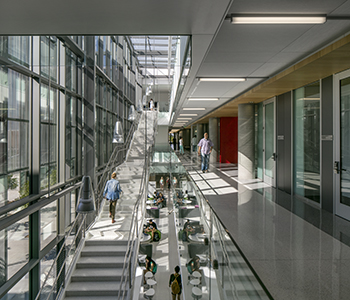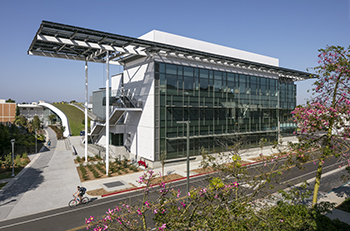 A transparent and open design helped the new 100,000-square-foot life sciences building at Loyola Marymount University (LMU) in Los Angeles showcase its science education. Opened in time for the university’s first day of classes last fall, the $110 million building features several ways for visitors to get a glimpse of the school’s research and curriculum in action.
A transparent and open design helped the new 100,000-square-foot life sciences building at Loyola Marymount University (LMU) in Los Angeles showcase its science education. Opened in time for the university’s first day of classes last fall, the $110 million building features several ways for visitors to get a glimpse of the school’s research and curriculum in action.
The modern and visually engaging building features 35 research and teaching laboratories, 9,000 square feet of faculty research space, a 273-seat auditorium and a three-story green roof. Los Angeles-based CO Architects served as the architect on the project, while Pasadena, Calif.-headquartered C.W. Driver served as general contractor and locally based Anthony Mason & Associates was the project’s construction manager.
The project team was primarily charged with upgrading the university’s science facilities in a way that would keep the university competitive in the sciences, accommodate growing interest in the field and ultimately meet the needs of students seeking a high-caliber science education, according to Tina Choe, dean of the Frank R. Seaver College of Science and Engineering at LMU.
“The new building has come to embody the university’s commitment to the sciences and the community,” Choe added. “The building promotes best practices in science education in a setting that incorporates some of the latest technologies. The building’s design facilitates active, hands-on experimental work.”
Programmatically, the university moved the science departments from an existing building that didn’t allow for easy or fluid interaction between the various disciplines, according to Arnold Swanborn, LEED AP BD+C, associate principal at CO Architects. “The primary goal was to create a building with an understanding that science is changing and is more interdisciplinary — or rather transdisciplinary,” he said. “The second thing is to really have the building be a tool for teaching, so it’s a building for science but also for natural science and botany.”
A Transparent Design
The facility was designed with new technologies to promote collaboration. Laboratory and research space take the place of traditional classrooms so that students will learn science by putting it into practice and integrating concepts with hands-on work to prepare future scientists.
The project’s objective to put science on display was achieved through openness and transparency in the design. This was carried out not only on the interior  of the building via research and teaching labs configured with floor-to-ceiling glass storefronts allowing students to observe what their peers are working on, according to Matthew Wilt, project manager at C.W. Driver, but also on the exterior with an auditorium that features an overhead green roof terrace that functions as an outdoor living laboratory.
of the building via research and teaching labs configured with floor-to-ceiling glass storefronts allowing students to observe what their peers are working on, according to Matthew Wilt, project manager at C.W. Driver, but also on the exterior with an auditorium that features an overhead green roof terrace that functions as an outdoor living laboratory.
“We used a lot of glass, so there’s a lot of transparency from the corridor into the classroom,” Swanborn added. “Science used to be behind doors and walls, but now it’s on display and becomes an interactive layer. That was a pretty important thing for us and involved a lot of relocation and rethinking of the laboratories. Lab planners and professors worked with us to make it a very open building.”
“In a reinterpretation of the classic Spanish Revival vernacular of the campus, we wrapped the program around an active central courtyard, while incorporating a three-story green roof connecting to outdoor terraces,” added Paul Zajfen, FAIA, design principal at CO Architects.
The C.W. Driver team had to account for the hundreds of thousands of pounds of weight created by the green roof, which rests on top of the steel-structured auditorium. To ensure the building would not droop or deflect once the green roof was added, the team used cables to ground and preload the steel structure to account for the future weight prior to installation, Wilt said.
Sustainable design and construction were also key elements of the project. Initially, the university’s goal was to achieve LEED Silver certification, but the project ultimately achieved LEED Gold through a number of measures taken to minimize its environmental impact. For example, the project features more than 8,200 square feet of solar panels that produce approximately 10 percent of the facility’s energy needs. Swanborn added that a significant amount of natural daylight was also introduced into the lab spaces.
Safety & Security
As the building houses sensitive scientific tools, materials and activities, the CO Architects team took specific safety concerns into account during the design process. For instance, Swanborn said that the design team carefully considered how the students would work with explosive and flammable chemicals — not what you would typically consider in a classroom building. In response, the team included things like gas and electrical shutoffs as well as safety showers in every lab. Standard laboratory fume hoods, which Swanborn considers a first line of defense against inhaling toxic chemicals, were included throughout. Other key security elements include security cameras and secure entrances.
Read more about this project in the upcoming June Safety & Security issue of School Construction News, available soon.

